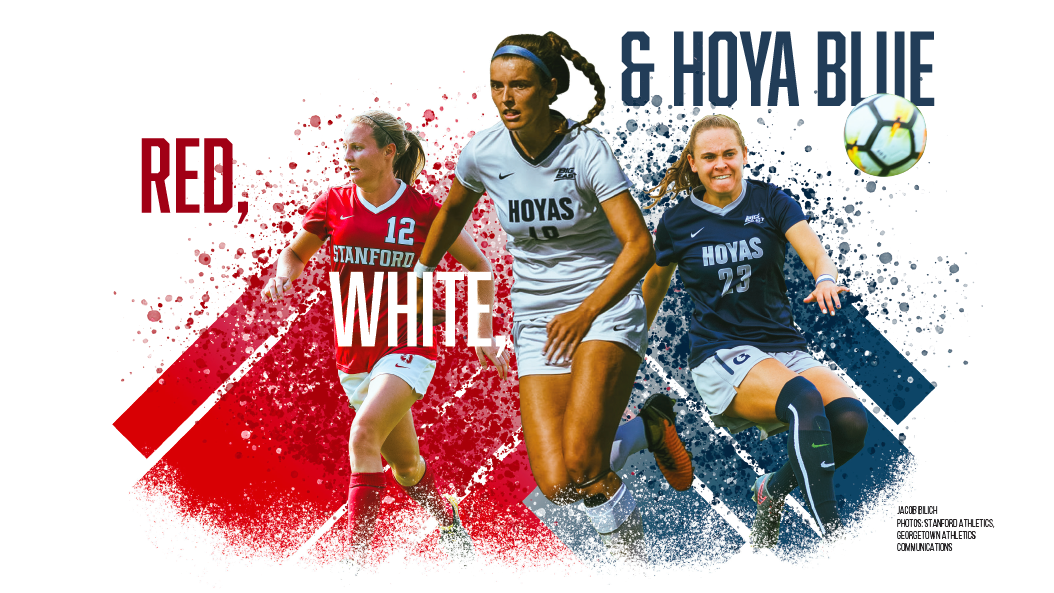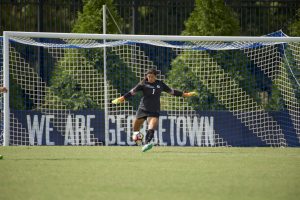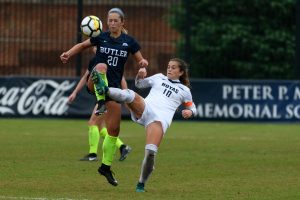On a Thursday night, after a hard spring season practice, Georgetown women’s soccer head coach Dave Nolan called the team into the huddle to give junior defender Meaghan Nally incredible news.
“Dave is like, ‘I have some news for you guys,’” Nally said. “So then he pulls out his phone and says, ‘Yeah, I got this email during practice.’ So then he starts reading it, and he’s like, ‘Hi Dave, I hope this finds you well. I’m asking for the immediate release of Meaghan Nally to attend the U.S. National Team camp,’ and then I was a little stunned, and then I just started crying because it’s a dream come true.”
In May, once practices for the year were over, senior forward Caitlin Farrell found out that she, too, would be headed to a national team camp. Although it wasn’t in front of the whole squad (only senior midfielder Meghan Shaver was with her at the time), the moment was no less special for her. A week after Nally, Farrell was due in Southern California, where the camps were held.
The U.S. National Team camps are week-long events that allow the national team staff to acquaint themselves with prospective international-level players. They’re a chance for the players to show that they can hold their own against other top-level talent in their age group, and the coaches use the camps to make roster decisions for future competitions.
On the women’s side, FIFA only holds international youth tournaments for the U-17 and U-20 age groups, but U.S. Soccer looks to evaluate as many players as it possibly can to prepare for the future of their competitive teams. As such, the American federation holds various camps aimed at high school and college-aged players who could potentially make the jump to the full team.
The legacy of the United States women’s soccer team (USWNT) speaks for itself. The U.S. has won three of the seven Women’s World Cups and four of six Olympic tournaments. Over that time frame, the Women’s World Cup has doubled in size from 12 to 24 teams, and the United States boasts a successful professional women’s soccer league after five years.
As the women’s soccer grows in popularity and the sport’s landscape changes, so too does the composition of the U.S. women’s national team. The national team’s early dominance was spearheaded by 21-time NCAA champion University of North Carolina (UNC): The 1991 and 1999 World Cup-winning teams had nine of 18 and eight of 20 players from North Carolina, respectively. In 2015, only six of the twenty-three players went to UNC.
“A long time ago, North Carolina made up 18 [spots] of the national team, and two other kids from two other schools,” Nolan said. “But now, over the last couple of years you’re starting to see kids coming in from Georgetown, from Rutgers, from Santa Clara. You’re getting to see kids coming in from smaller soccer schools because it just shows there’s more talent.”
At the start of Nolan’s tenure as head coach, Georgetown did not send any players to these illustrious camps. However, after former midfielder Ingrid Wells’ (COL ’11) standout freshman season on the Hilltop in 2007, Nolan successfully pushed for her inclusion in a U-20 women’s national team camp. By the summer of 2008, Wells played alongside USWNT stars Sydney Leroux and Alex Morgan at the U-20 World Cup, helping the US win the tournament and putting Nolan and Georgetown on the national team’s selection radar.
“I have that little bit of trust with national staff when I call and talk to them about players, they’ll know that I’m not just pushing them for the sake of pushing them,” Nolan said. “I’m grateful that the program is at the stage now where our players are worthy of getting a look, then they go in and do their best and see what comes out of it.”
Since Wells’ breakthrough, Nolan has continued to recommend his players to the national team staff. Former defender Emily Menges (COL ’14), former midfielders Daphne (COL ’15) and Rachel Corboz (COL ’18), and senior goalkeeper Arielle Schechtman have all participated in national team camps under Nolan.
The consistent presence of Georgetown players at national team camps in the past decade has helped Nolan attract a caliber of player to Georgetown who may have previously looked past it.
“We always say to [recruits] that ‘Hey, if you have goals to wear a national team shirt or play professional, you can achieve that here, and here’s the proof,’” he said. “We point to Ingrid [Wells] winning a gold medal, and we point to Emily Menges playing for Portland Thorns, and we point to Daphne [Corboz] playing for Manchester City in England and now Rachel [Corboz] playing for FC Fleury in France, and [Elizabeth Wenger (MSB ’18)] playing in Switzerland, so we’re able to say to kids, ‘Whatever your soccer goals are you can achieve them here.’”
This summer, it was Nally and Farrell who got the nod to travel to Southern California. Nally was selected for the U-19 camp, while Farrell headed to the U-23 camp along with graduate student forward and future teammate Kyra Carusa (SCS), who transferred to Georgetown for the 2018 season after graduating from Stanford.
The camps challenge players with a higher level of play than in college because they aim to draw the best in the nation, but Nally first felt the heightened intensity mentally. Despite their jet-lag, the U-19s were immediately firing on all cylinders.
“The first day was just kind of a recovery session since we had all traveled that day, and we were just doing simple five versus two rondos, which is just keepaway,” she said. “We did it for three minutes, and right as we stopped, everyone there immediately started talking to each other and saying, ‘Here’s what we need to be doing better. What can we do better?’”
Nally’s camp ran concurrently with the U-18s. On the final day, they were joined by the U-20 team that was preparing for the U-20 Women’s World Cup. The three age groups combined on that last day to play a six versus six small-sided tournament.
The U-23 camp was entirely made of current NCAA players, as U.S. Soccer runs two different U-23 camps to minimize players’ time away from their teams and runs the camp for professional players during the college season. As with Nally and the U-19s, the team didn’t play any competitive matches, but for the national team coaches, time spent with the players in a practice setting is invaluable. Nolan has made the most of these types of camps to give his players looks and help them get their feet in the door.
“The 19s is usually the first look at kids to prepare them for the next U-20 cycle, and the 23s is usually [because] they want to get to know kids, see what their attitude is like, see what their training is like, see what their skillset is like, so that they know who to evaluate, because they’re constantly evaluating the young players in the league anyway,” Nolan said. “The higher up the ladder you go, the less opportunities there are, but U.S. Soccer does a great job of looking for talent that may have been missed.”
The camp also gave Carusa a chance to get acquainted with one of her new teammates. She played her undergraduate career at Stanford, and didn’t know anyone on the Georgetown squad aside from Schechtman, her close friend from San Diego. Playing with Farrell, her future strike partner on the Hilltop, was a bonus.
“It was cool to be able to talk with Caitlin about the upcoming year and kind of be excited with her about those things and ask her questions about the Georgetown team that I was coming into,” Carusa said. “I liked having this earlier meeting, in a soccer context too because then I got to see her play.”
While this was Carusa’s second national team camp, it was the first for Farrell, who had a breakout junior season for Georgetown. She started all 21 games and stepped more into the spotlight of the Hoyas’ offense, notching eight goals and three assists on the year.
“I knew this was going to be an entirely new experience for me, so I didn’t really know what to expect. I didn’t really know anyone there very well, so it was nice going in knowing that this girl is going to be on my team,” Farrell said.
The camps are designed for national coaches to get a sense of players’ personalities rather than technical development, but the players have consistently come back and make a greater impact for Georgetown than the year before.
“What gets them into national team camp is the skill set they have,” Nolan said. “What it does is it gives them confidence to come back and know that they’ve just played with some of the best players in the country. They can come back here and do well for us.”
With one exception, Nally, Farrell, and Carusa have started every game for the undefeated Georgetown team. Carusa and Farrell’s time together at camp has paid off, as the two have combined for 12 goals and four assists, directly contributing to 14 of Georgetown’s 19 goals through the first 10 games. Nally has been a rock at the back, heavily contributing to the Hoyas’ six clean sheets while continuing to bomb forward in attack, and getting the game winning goal at West Virginia over Labor Day weekend. The three recognize that their work isn’t finished. Their desire for more opportunities with the national team has shown in their play, both as individuals and for the Georgetown team as a whole. At camp, there were no mental breaks.
“You train a lot every day of the week, you’re playing games–soccer goes on for 12 months basically–and sometimes you can forget that you can get better every day,” Carusa said. “When you’re at camp it kind of rejuvenates that in you, and it reminds you that you can learn from your teammates, you can learn from your coaches, you can be better that day even though it’s just another day of training.”
It’s a drive beyond just having a successful season, but to continue on in their careers and have future chances with the national team, following in the footsteps of Hoya greats from the past decade.
“It just gives me a taste of exactly where I want to be and what I want to do,” Nally said. “Okay, that’s where I want to be, that’s what I want to do. Let’s go home, let’s go get better.”
Despite not playing any official matches, the prospect of pulling on the same jersey as Mia Hamm, Abby Wambach, and Carli Lloyd is magical in and of itself.
“One of the coolest things was sitting down in the first film session, and they pull up film and it’s film of U.S. Soccer, and you’re like, ‘That could be me, people could be watching film on us at some point,’” Carusa said. “Someone saw something in you and chose you, out of everyone else in the nation, to come to this camp and represent the US.”
And while the future possibilities are exciting, the moment of walking into the locker room itself was just as special.
“When you see your name above your locker and it has the U.S. crest to it,” Farrell said, “it kind of makes you feel like ‘Wow, I’m really here. I’m representing my country.’”





